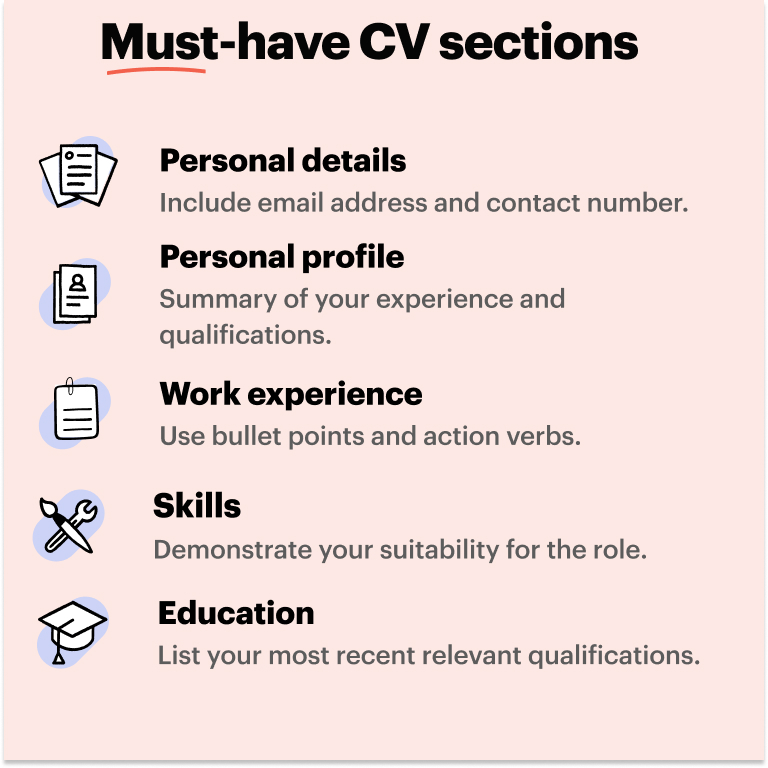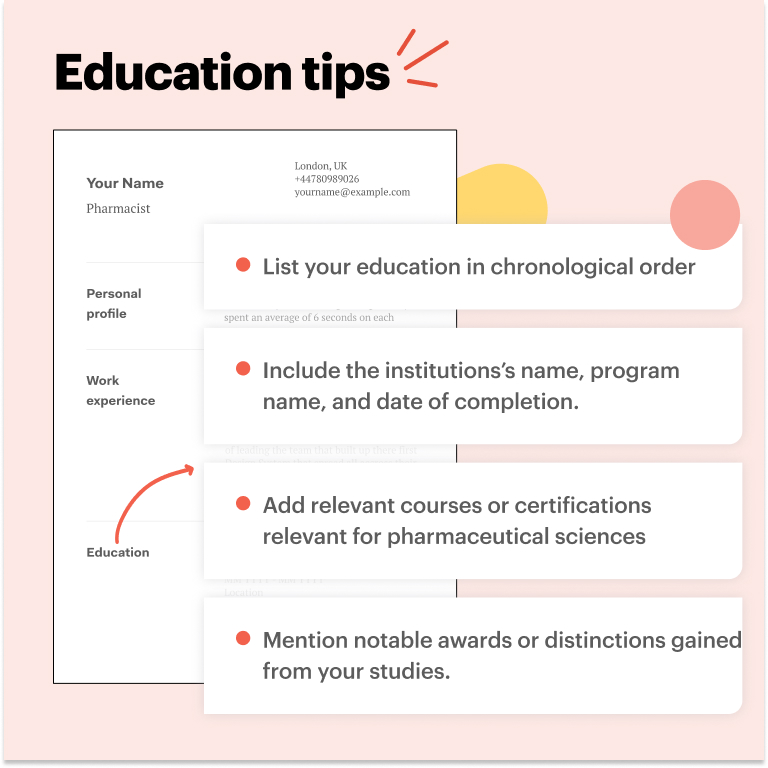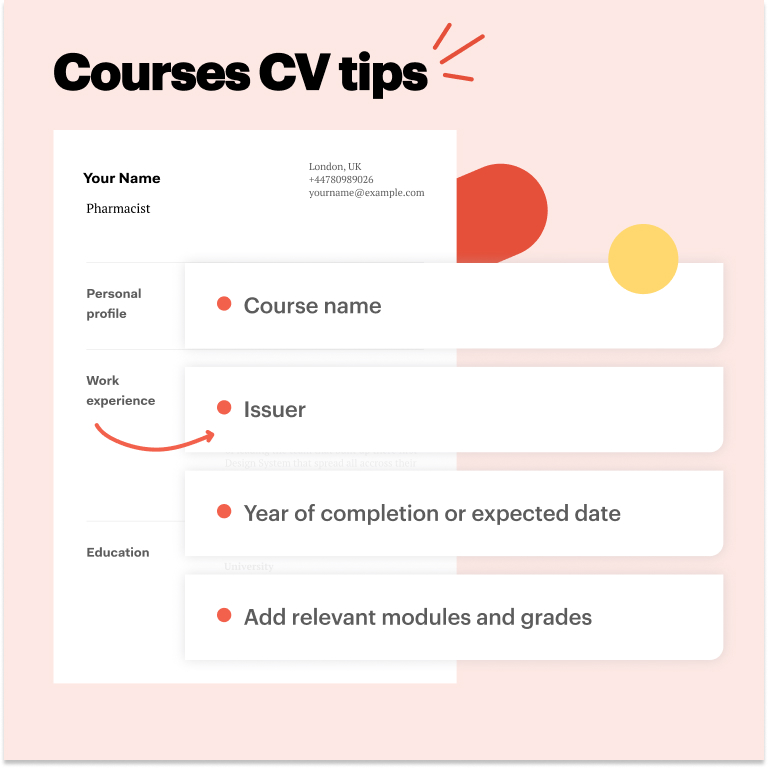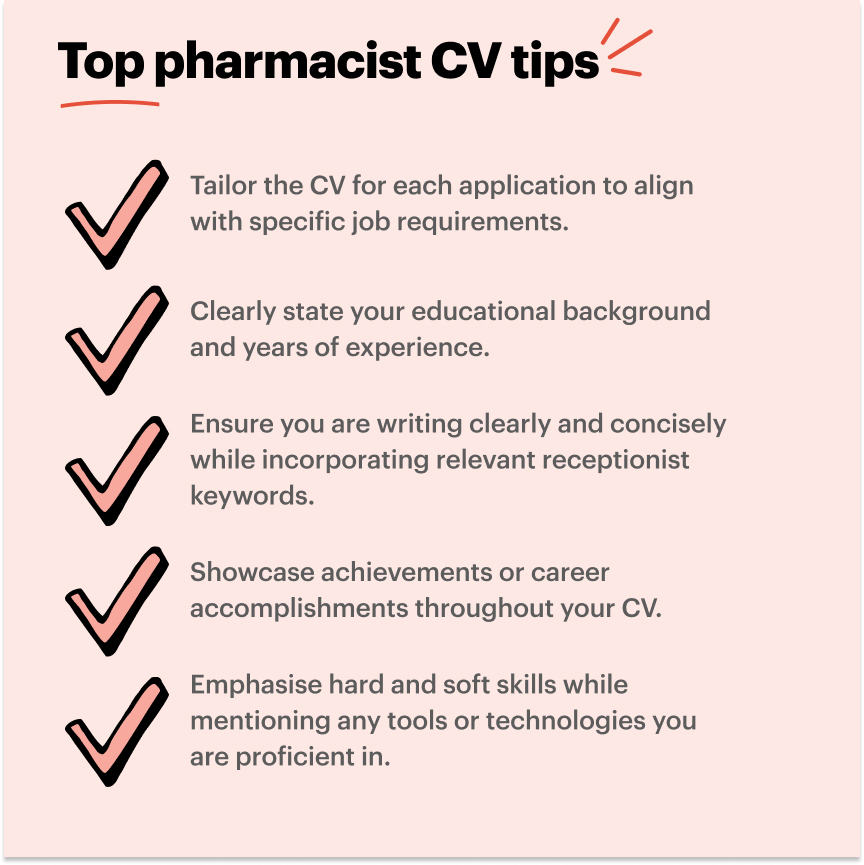
How to Write a Pharmacist CV (Examples & Tips)
A pharmacist works closely with physicians, nurses, administrators, and other allied health professionals to ensure patients receive the correct medication in the right quantity. If you have a keen eye for detail and empathy towards others, this profession might be a perfect fit for you.
The first thing you need is a well-structured CV to set yourself apart in this competitive market. Whether you're a student or seeking a career change, our step-by-step guide provides real-life examples and essential tips to help you craft a good CV meeting industry standards.
Explore our diverse collection of professionally crafted CV templates to help you finalise your application and apply this career advice to practice.

Pharmacist CV example

Download this pharmacist CV sample in PDF
This pharmacist CV sample features Julia Dawson, a senior clinical Pharmacist experienced working in diverse healthcare settings, with a passion for science and improving health outcomes. Her profile highlights her strong interpersonal skills, with expertise in drug therapy, safety monitoring, and patient education. The California template coupled with a professional design presents her skills and experience in a clear and visually appealing manner.

To help you streamline your application, see our matching pharmacist cover letter example article.
What to include in a pharmacist CV?
Whether you're a clinical pharmacist or a pharmacist assistant, a well-crafted CV should highlight your experience, skills, and tangible achievements, demonstrating your ability to provide pharmaceutical services efficiently. Highlight your proficiency in pharmacy software, problem-solving, and teamwork, which are vital skills for this career.
If you are a school leaver or seeking an apprenticeship, you could switch the focus to education and certificates to distinguish yourself from other candidates with similar qualifications. Share notable accomplishments in previous roles, such as a pre-registration (pre reg) pharmacist or locum pharmacist. Lastly, mention relevant professional affiliations or volunteer experience in 'Additional experience' section.
Consider that certain sections come highly recommended, others are optional and should be included based on their relevance to your career goals.
Must-have sections:
Personal details
Personal profile
Work experience
Skills
Education
Optional sections:
For more tips on to enhance your content, read the article on how to improve your CV.

How to add a personal profile for a pharmacist CV
A personal profile, also known as a personal statement or career objective, is a section at the top of your CV that briefly mentions relevant experience, soft skills, and qualifications for the desired pharmacy job. It is usually the first thing recruiters or hiring managers read when looking at your CV. Therefore, it should be well-written. For more examples, see our assistant pharmacist CV sample, pharmacist for a newly qualified role, pharmacist fresher, and others below to learn how to craft a professional and concise summary.

Clinical Pharmacist CV personal profile example
Patient-centred Clinical Pharmacist with 5+ years of experience in medication therapy management, patient counselling, and disease state management. Proficient in evidence-based medicine and integrating clinical pharmacy services into the healthcare system. Motivated and collaborative professional dedicated to providing exceptional service to patients.
Hospital Pharmacist CV personal profile example
Experienced hospital Pharmacist with a passion for delivering high-quality patient care. Skilled in aseptic techniques, intravenous drug preparation, and dispensing. Possess strong knowledge of hospital pharmacy regulations, policies, and procedures, ensuring that all medication-related practices are carried out with precision and accuracy.
Community Pharmacist CV personal profile example
Knowledgeable and friendly community Pharmacist with 6 years of experience in dispensing, counselling, and health promotion. Skilled in managing medication-related problems, patient education, and over-the-counter medication recommendations. Committed to providing exceptional customer service and improving patient outcomes.
Clinical Pharmacologist CV personal profile example
Compassionate clinical pharmacologist with 6 years of experience in hospital and community settings. Strong clinical knowledge, including medication therapy management, drug interactions, and pharmaceutical calculations. Skilled in patient-centred care and collaborating with healthcare teams to improve patient outcomes.
Pharmacy Manager CV personal profile example
Results-orientated Pharmacy Manager with 10+ years of experience managing pharmacy operations, driving sales growth, and overseeing staff development. Proven ability to maintain compliance with industry regulations, develop robust quality assurance processes and streamline workflow processes to optimise pharmacy performance. Adept at leveraging strong communication and leadership skills to develop and maintain productive relationships with patients, physicians, and pharmacy team members.
Pharmaceutical Sales Representative CV personal profile example
Detail-orientated Pharmaceutical Sales Representative with 3+ years of experience in building relationships with healthcare providers, increasing revenue growth, and driving brand awareness. Strong knowledge of the pharmaceutical industry and product portfolios. Proven track record of delivering sales targets while upholding ethical standards in the delivery of patient care.
Refer to the article on how to write a personal profile on a CV to see more examples and tips.

How to write a pharmacist CV with little to no experience
Prioritise your education section over work experience by adding more information about your relevant courses, transferrable skills, and research projects. Position this section at the forefront of your CV before listing the side jobs or internships you've held. If you are writing your pre-registration CV, consider using a skills-based CV, focusing abilities and competencies rather than chronological work history. We also suggest creating a separate section called ‘Additional experience’ where you can further expand on your part-time and voluntary work you my have. Lastly, mention relevant hobbies and interests in your CV or cover letter and elaborate on them in your job interview.
Example of little to no work experience for a pharmacist:
Pharmacy Trainee, NHS, Birmingham, UK, 2024-Present
Assisted pharmacy staff with prescription processing, customer service, and inventory management tasks. Maintained stock levels and assisted with medication orders to ensure timely availability. Provided basic counselling to patients on medication usage under supervision.
Contributed to enhancing medication adherence through participation in patient education initiatives.
Supported cost-saving measures by effectively managing inventory and identifying opportunities for waste reduction.
Collaborated with healthcare professionals to uphold medication dispensing accuracy and patient safety.
See the internship CV example articles for more guidance on how to get started with your career.
How to write work experience on a pharmacist CV
Start by listing your past positions in reverse chronological order, with the most recent positions being first. Use concise sentences and action verbs, such as 'Dispensed', 'Collaborated' or 'Developed' to summarise your duties and tangible achievements in 4 to 6 lines. Showcase your areas of expertise, such as strong communication skills and extensive knowledge of pharmacy software. Remember to adhere to a modern CV format and each job entry to the specific job you're applying for.
For more tips and examples, see our related care assistant and nurse articles.
What should each work experience entry include?
Job title of current or previous role
Organisation name and location
Dates of employment (month/year)
A concise paragraph detailing your duties
Followed by 2–3 bullet points that highlight your key achievements or measurable impact.
Learn more about the work experience section in a CV.
Pharmacy Manager, Boots Pharmacy, London, UK, 2018-2021
Managed a team of pharmacy technicians and ensured the timely processing of prescriptions, exceptional customer service, and proper inventory management. Maintained inventory levels and ordered medications in a timely and cost-effective manner. Counselled patients on medication usage, potential side effects, and drug interactions.
Collaborated with doctors to develop effective medication plans resulting in a 10% increase in patient adherence to prescribed treatments.
Decreased medication costs by 10% through effective inventory management, sourcing cost-effective suppliers, and minimising drug waste via storage and expiration tracking in accordance with the pharmaceutical guidelines.
Collaborated with doctors and healthcare professionals to create effective medication plans, resulting in a 10% increase in patient adherence to prescribed treatments.
Care Home Pharmacist, Superdrug, Manchester, UK, 2024-Present
Work closely with physicians, nurses, and other healthcare providers to review medication regimens, address drug-related concerns, and optimise therapy outcomes. Ensure accurate dispensing, administration, and monitoring of medications for residents according to personalised care plans. Provide continious onboarding and training to staff on medication safety, proper administration techniques, and recognition of adverse drug reactions or side effects.
Organised monthly medication safety workshops for care home staff at "Prestige Care Homes," resulting in a 30% increase in staff confidence in handling medication-related issues and a decrease in medication administration errors by 25% over one year.
Conducted medication reviews for residents, leading to a 15% increase in medication adherence rates as evidenced by fewer missed doses and improved health outcomes.
Implemented a medication reconciliation process resulting in a 20% reduction in medication errors within the care home facility at "Prestige Care Homes" over the course of six months.
GP Practice Pharmacist, LloydsPharmacy, Birmingham, UK, 2019-2023
Conducted medication reviews for patients with chronic conditions, ensuring that prescribed treatments align with evidence-based guidelines and patient preferences. Collaborated with general practitioners to develop comprehensive medication management plans for patients, focusing on optimising therapeutic outcomes and minimising adverse drug reactions.Provided medication counseling and education to patients during one-on-one consultations, addressing concerns about medication usage, side effects, and interactions.
Implemented a medication adherence program targeting high-risk patients, resulting in a 15% improvement in medication adherence rates within the clinic.
Streamlined medication inventory management processes, reducing stock wastage by 20% and ensuring that essential medications were consistently available for patients.
Led a team-based initiative to improve chronic disease management, leading to 10% reduction in hospital readmissions among patients with complex medication regimens.
How to include skills for a pharmacist CV
Adding relevant skills on your CV is more straightforward than you might think. Create a separation section called 'Skills' and list your hard skills there. As for the soft skills on a CV, incorporate them in a personal profile section instead. A successful pharmacist needs to be thorough, patient, and able to stay calm under pressure. They also have excellent customer service and verbal communication skills, enabling them to effectively advise customers on over-the-counter medications and provide guidance on dosage and medication types.
Explore our closely related chemist CV guide fore more inspiration.
Must-have skills for your pharmacist CV
| Soft skills | Hard skills |
|---|---|
| Communication | Medication dispensing |
| Collaboration | Pharmaceutical knowledge |
| Detail-orientated | Quality assurance |
| Compassion | Pharmaceutical research |
| Teamwork | Medication dispensation |
| Customer service | Prescription processing |
| Leadership | Drug interaction management |
For more information, see our blog article on how to list skills in your CV.
How to list education on a pharmacist CV
You need to add the relevant qualifications to your CV which are applicable to the job you are applying for. Choose the qualifications that highlight specific knowledge and skills needed for the job. If you are enrolled or have completed a pre-registration program, include this on your CV. Take a look at the following tips and examples to effectively write the education section on your CV:
Begin with your highest level of education and work backwards in chronological order. List the name of the institution, the degree earned, and the graduation date. If you are still enrolled in your master's of pharmacy, just add 'in progress' in the education section.
Any additional qualifications like the pharmacist foundation training scheme should also be included in the education section.
If you are a recent pharmacy student or have limited work experience, you can highlight relevant coursework that demonstrates your knowledge and skills in accounting. Consider a skills-based CV, or refer to our graduate CV example for more information.

Examples of education:
Master of Pharmacy, University College London, UK, 2023-In progress
Bachelor of Pharmacy, University of Manchester, UK, 2022
Read our article on how to list education on a CV to find out more.
How to list courses and certificates on a pharmacist CV
When listing courses and certificates on a CV, highlight those that are most relevant to the job you are applying for. Here are some tips to help you effectively list courses and certificates on your CV.

Examples of courses and certificates:
Foundation Pharmacy Framework, Royal Pharmaceutical Society (RPS), 2022 Independent Prescribing course, Keele University, 2023
Medicines Use Review Training Program, University College London (UCL), 2023
Clinical Pharmacy International Practice Certificate, University of Manchester, 2022
Pre-registration Pharmacist Training Program, General Pharmaceutical Council (GPhC), 2022
Key takeaways
Drawing on the above examples and tips, you are now equipped with all the knowledge to be one step ahead of your competitors. We have covered what makes a good pharmacist CV, the types of sections to include, and the importance of making it applicant tracking systems (ATS)-friendly. Use our expert knowledge to craft a well-structured CV that showcases your unique abilities and achievements. Apply with confidence, and let your talents shine in your next job!
Additional tips for a pharmacist CV:
Ensure you use simple and professional language
Personalise your CV to meet job requirements
Include a cover letter alongside your CV
Avoid using personal pronouns such as ‘I’, ‘me’, or ‘us’ in your CV
Exclude outdated information
Proofread your CV for any errors or inconsistencies
Seek feedback from experienced professionals
Read your CV and cover letter aloud before handing them in
Use up-to-date and accurate information

Next steps?
Do you need help crafting professional CV template for a pharmacist? See our intuitive CV builder where you can easily personalise and improve your career documents within a few clicks. Our CV Writing Service offers quick reviews and complete rewrites, ensuring your CV targets keywords and includes all essential sections. Benefit from our all-in-one career platform, receive feedback from industry professionals, and attach a compelling cover letter to showcase your qualifications.
Remember that your CV complements other career documents such as cover letters, thank you letters, and LinkedIn profiles. Instead of including all of your experiences on a CV, strategically use all available resources to market yourself effectively.
For more inspiration, explore our retail and customer service guides for more examples and valuable tips from related industries.

FAQ
How many pages should a pharmacist CV be?
A pharmacist CV should ideally be kept concise, spanning no more than two pages. This ensures that key qualifications, experience, and skills are highlighted effectively without overwhelming the reader. Prioritise the most important information to showcase your suitability for the role.
For more information, refer to the related blog article on how long should a CV be.
What are relief and locum pharmacists?
Relief pharmacists and locum pharmacists share similar job functions, but the main difference lies in the nature of work contracts. Relief pharmacists receive assignments through agencies or job-matching sites, whereas locum pharmacists work independently as ‘freelancers’ and need to look for open shifts themselves. This distinction highlights how relief pharmacists rely on external sources for work opportunities, whereas locum pharmacists take a proactive approach in managing their assignments.
How to write a CV from a community to a GP practice pharmacist?
Mention your experience in providing clinical services, team collaboration with other healthcare professionals, and patient care. Furthermore, showcase your knowledge of medication management, dispensing, and patient counselling. Additionally, emphasise any relevant certifications or professional training, such as in clinical pharmacy. Finally, demonstrate your ability to adapt to new environments and communicate effectively with diverse healthcare teams.
If you're switching roles, you could mention this in a cover letter clearly stating your intention to apply your previous knowledge and skills in a new role. For more information on this, see our closely related article on how to structure a cover letter.
What is the average salary of a pharmacist in the UK?
Salaries can vary depending on factors such as experience, location, and size of the organisation. The average salary in the UK is around £40,000 per year, with senior positions or executives earning up to £70,000 per year. Refer to National Career Services for more information on salary depending on your specific role and level of experience.
Additionally, check out our related blog article on the highest-paying jobs in the UK for more information on career prospects and average salary for pharmacy roles.
How to become a pharmacist?
In the UK, you need to have a degree in pharmacy from an accredited university or get certifications from institutions such as the General Pharmaceutical Council (GPhC). The degree typically takes four years to complete and includes both academic coursework and practical experience. After completing the degree, you must complete a one-year pre-registration training program and pass a registration exam before being able to practise in this field. Overall, working in pharmacy is a rewarding career path, enabling you not only to help people and improve health outcomes but get to work in various industries and settings.
For more information on needed steps to become a pharmacist, consult the NHS website.
Where to look for pharmacist jobs in the UK?
You can work in different settings, such as retail, hospitals, or government agencies. You can find vacancies on the following job sites or various association platforms:
Job search sites:
Pharmacy associations:
What to put on an NHS CV?
Include your relevant qualifications, such as your degree in Pharmaceutical Sciences and accredited certifications. Highlight experience working in the healthcare sector, focusing on roles where you demonstrated excellent customer service or collaborated with different professionals such as nurses or caregivers. Ensure to mention any specific competencies, aligning with the NHS requirements, such as knowledge of NHS protocols and guidelines.
For more specific requirements, consult the NHS article or explore our closely related guide on how to write a medical CV.

